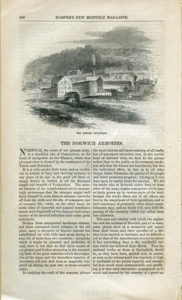 During the late summer of 1862 in the midst of the American Civil War, John Almy received a contract from the United States War Department to manufacture and deliver 20,000 Springfield Model 1861 rifle muskets to the Union army. Almy, the owner of a textile mill in Mansfield, Connecticut formed a partnership with James Mowry who had been awarded a similar contract.
During the late summer of 1862 in the midst of the American Civil War, John Almy received a contract from the United States War Department to manufacture and deliver 20,000 Springfield Model 1861 rifle muskets to the Union army. Almy, the owner of a textile mill in Mansfield, Connecticut formed a partnership with James Mowry who had been awarded a similar contract.
They purchased space in a machine shop on North Main Street in Norwich and a building in Greenville that was formerly used to repair train cars for the Providence & Worcester Railroad. Machinery to manufacture the Springfield rifle muskets was installed soon after and by January of 1863, the newly formed Norwich Arms Company had 500 employees briskly producing muskets for the Union army.
All forty-nine components of each musket were manufactured from raw materials (wood and iron) on site by the company. During the final stage of manufacturing, workers in the assembly room could put together each musket in approximately ten minutes. The first delivery of 500 muskets to the government was made in June of 1863. Thereafter with the manufacturing process at full stride, the company was capable of producing 1,000 to 2,000 muskets with bayonets each month. The company also manufactured a relatively small number of breech loading rifles that were considered to be the next step in the evolution of long guns.
The Norwich Arms Company satisfied the terms of its second federal contract delivering ten thousand muskets to the government on May 30, 1864. Another delivery of Springfield Model 1861 muskets met the third contract deadline in December of the same year. The year 1864 would turn out to be the peak of arms production for the company for several reasons.
The first reason was the dwindling number of federal contracts available to private manufacturers of armaments. The armories of the federal government were fully stocked, reducing the demand for new weapons. Second, by early 1865 it was clear that the war was winding down and the surrender by the Confederacy was imminent. The final reason was the growing obsolescence of the muzzle loading technology.
The Civil War had been the catalyst for the inception and rapid growth of the Norwich Arms Company. Likewise, the end of the war was the cause for the company’s rapid decline. With the end of federal contracts and the lack of their own design patents for civilian firearms, the company’s revenues were reduced to a trickle. The Norwich Arms Company closed down its manufacturing operations in 1866.
To view the 1864 Harper’s magazine article and images of the Norwich Arms company, visit the Otis Library’s Flickr site.
